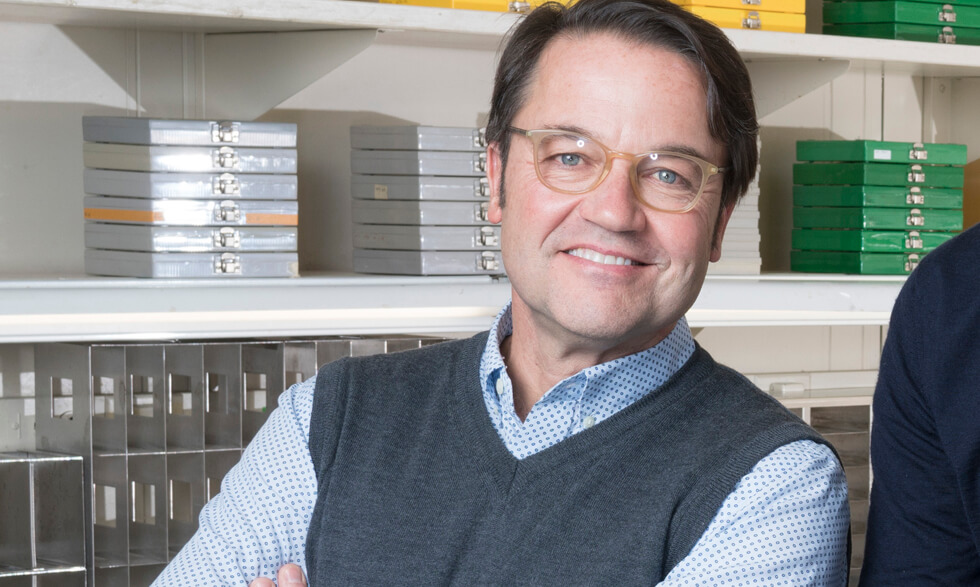
NIH’s Clinical Center is divided into two parts.
One side is a hospital for patients. The other side includes offices and labs where researchers like John Tisdale, M.D., and Steven Rosenberg. M.D., Ph.D. work.
Dr. Tisdale and Dr. Rosenberg are senior investigators at NIH. Their title is fitting as they are not simply doctors or researchers. Their teams bridge the gap between the two.
Using a mix of science, patient care, and medical detective work, they answer some of medicine’s most difficult questions.
“The Clinical Center is a unique place. Investigators focus on diseases from the bench all the way to the bedside.
We can take risks on harder-to-accomplish therapies and bring them to the clinic all under one roof,” Dr. Tisdale said. “That’s really an extraordinary opportunity for those of us who are trying to make a difference in a disease.”
Strides in sickle cell research
There are more than 1,600 clinical research studies taking place at the Clinical Center today.
One of the four studies featured in “First in Human” was led by Dr. Tisdale, who has worked at NIH since 1994.
He helps lead the Clinical Center’s sickle cell disease research. NIH has a history of making important advances in sickle cell research.
NIH investigators, including National Institute of Diabetes and Digestive and Kidney Diseases Director Dr. Griffin P. Rodgers, M.D., had earlier developed the first effective, FDA-approved therapy for sickle cell anemia.
“First in Human” follows Dr. Tisdale and his team in their groundbreaking work using stem cell transplants to stop the rare blood disease in its tracks.
The transplants help patients with sickle cell disease produce normal red blood cells and stop producing sickle cells by altering bone marrow.
One of their patients with sickle cell disease, Deidra Williams, came to the Clinical Center with no other options. Her excruciating pain, which most sickle cell patients have to deal with constantly, was making normal things hard to do.
But thanks to Dr. Tisdale’s team and the first in human trial, she had a successful stem cell transplant from her sister and now lives free of the disease.
For more than a year, Discovery’s documentary crew filmed Dr. Tisdale’s team as they met with Deidra and worked in the lab. Although it took a little adjustment, the film crew and research team quickly found a routine.
“It felt awkward at first but Discovery was so professional and the producers and film crew almost became members of our team,” he added. “We really got to know each other and that made it so much easier.”
Dr. Tisdale said he wanted to be a part of the documentary to highlight life-altering diseases and the brave patients living with them.
“This was an opportunity to give patients with sickle cell disease a voice and to get recognition for this horrible disease,” Dr. Tisdale said. “I also wanted people to know our tax dollars are being used wisely to move towards cures for this and many diseases that are studied here at the Clinical Center.”
Cancer breakthroughs
Dr. Steven Rosenberg is a pioneer in the field of cancer research. For decades he has investigated the immune system’s role in cancer treatment. This immunotherapy work has been critical to advancing care.
Some of his team’s latest immunotherapy research was featured in “First in Human.” It focuses on using lymphocytes, a white blood cell in the immune system, to attack cancer that has spread.
In the documentary, researchers led by Dr. Rosenberg and Stephanie Goff, M.D. explore removing lymphocytes found in cancerous tumors, altering them to help them fight off cancer, and putting them back into patients.
The research has already shown promise for skin and breast cancer.
Since joining NIH in 1974, Dr. Rosenberg has worked on numerous first in human trials that have led to major treatment breakthroughs.
One message he has to patients considering a first in human trial is to keep in mind that there are years–and often decades–of research and testing that come before it.
“Studies with patients are based extensively on studies in the laboratory. Before anything ever gets to humans, there’s a lot of research that takes place,” said Dr. Rosenberg. “Most people don’t realize how much preparation goes into that first patient.”
Working for patients
Though first in human trials involve risk, they also hold great promise. They are often a patient’s last treatment option.
That is something NIH staff like Dr. Rosenberg and Dr. Tisdale think about all the time.
“NIH is often referred to as the National Institutes of Hope. These patients have exhausted all other treatments that might be effective and are quite advanced in their disease. They come to NIH with hope that there’s something new that might be of value to them,” Dr. Rosenberg said.
“And, as this documentary has demonstrated, very often these first in human patients can be treated with something quite new that can have dramatic results and dramatic improvements,” he added.
